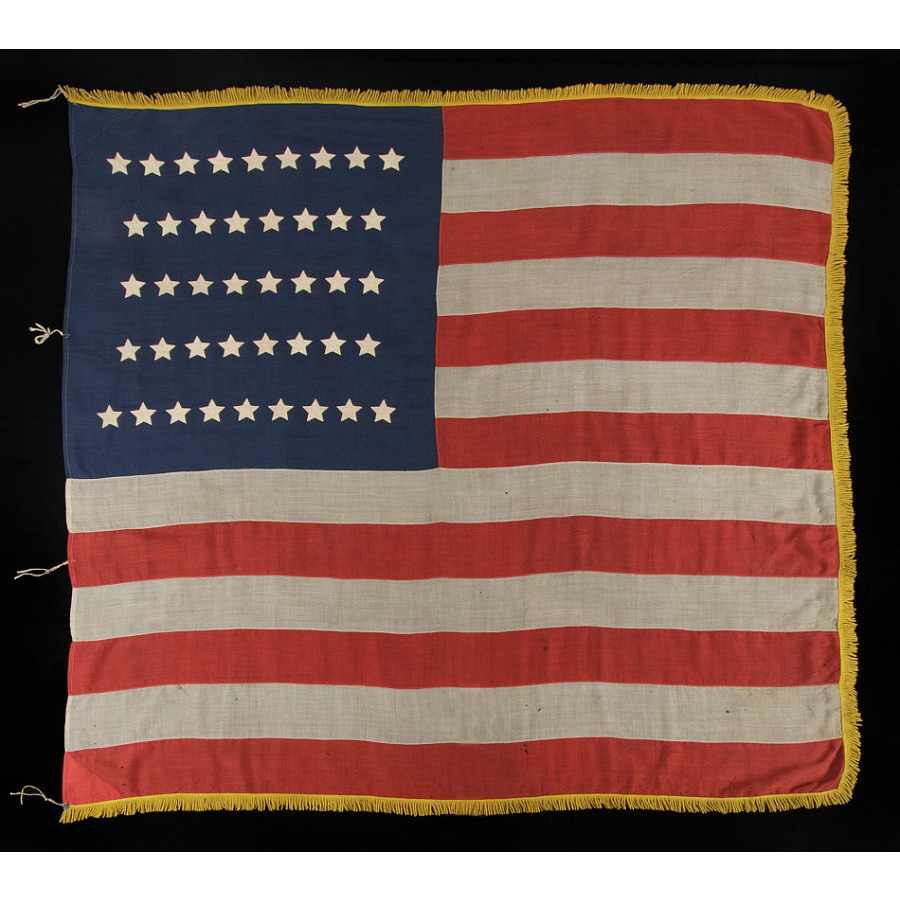
| |
UNITED STATES INFANTRY BATTLE FLAG WITH A RARE ARRANGEMENT OF 42 STARS, AN UNOFFICIAL STAR COUNT, LATE INDIAN WARS PERIOD, WASHINGTON STATEHOOD, 1889-90 |
|
| Available: |
Sold |
| Frame Size (H x L): |
n/a |
| Flag Size (H x L): |
74.25" x 73.25" |
|
| Description....: |
|
UNITED STATES INFANTRY BATTLE FLAG WITH A RARE ARRANGEMENT OF 42 STARS, AN UNOFFICIAL STAR COUNT, LATE INDIAN WARS PERIOD, WASHINGTON STATEHOOD, 1889-90:
This rare 42 star flag, with applied gold fringe, is a United States infantry battle colors of the late Indian Wars period. Its stars are arranged in a very unusual lineal pattern that neither conforms to common practice in the production of 42 star flags or mathematical logic. When stars were placed in rows or columns, if the count was easily divisible into an equal number that could be displayed on a square or rectangular canton, such as 5 rows of 6, or 6 rows of 6, or 6 rows of 7, that was typically the method of choice. In this case the maker chose 2 rows of 9 stars with 3 rows of 8 sandwiched in between. This is peculiar, not only because almost all 42 star flags have either 6 rows of 7 stars, or 7 columns of 6 stars, but also because American flags are seldom ever encountered in any period with rows that include more than 8 stars. A number exist, but they are rare and the star arrangement on this flag is unique among known examples.
19th century, Stars & Stripes format, U.S. Army regulation battle flags are very scarce on the private market. I encounter a small number of them each year and they are always an exciting find. Because there was no official way to arrange the stars on the American flag until 1912, the design was left up to either the flag maker, or the party who ordered their production. Variation could thus be expected in this feature, but since star counts increased by United States Congressional Law following the flag Act of 1818, one might expect that the star count at the very least would conform to some official number. That is not the case here, however, because 42 was never an official count for the American national flag.
The 42 star flag is interesting from a historical perspective, both because 42 was never an official star count, and because 42 star flags were only produced for about 8 months (November, 1889 – July 4th, 1890). The flag represents the addition of the Dakotas, Montana and Washington State, between November 2nd and November 11th, 1889. The 42nd state was officially Washington, but the four states gained their statehood only nine days apart and flag makers added four stars, accordingly, to the 38 star flag that was previously official.
After 1818, star counts became official on the 4th of July each year. A new star was therefore officially added on Independence Day for every state that had been added over the preceding “flag year”. Flag makers, however, did not wait for July 4th and official star counts. Flag making was a competitive industry, and no one wanted to be making 38 star flags, for example, when their competitors were making 42 star flags and there were 42 states. Idaho received statehood on July 3rd, 1890, taking the star count to 43 just one day before 42 would have become the official number. This fact makes 42 star flags an interesting part of our heritage and a classic display of American capitalism.
While 42 stars is an unusual choice for a military flag, the officer or personnel acquiring them probably bought what was available. One might also expect that a count of stars that reflected the actual number of states, rather than a current official star count that lagged behind it, to be especially appropriate for military units that were deployed in territories that had just acquired statehood. Military flags are known in at least one other unofficial counts that was produced during this period. One 40 star example is known in this traditional, near-to-square, six-by-six-and-a-half-foot profile, typical of infantry battle flags, and numerous, rectangular, press-dyed 40 star flags have surfaced that may have been regularly sold for military purpose.
Construction: The stripes and canton of the flag are made of wool bunting that has been joined with treadle stitching. Triangular gussets were included for support in the upper and lower corners of the hoist end. The stars of the flag are made of cotton and are double-appliquéd (applied to both sides of the flag) with a lineal treadle stitch. Along the hoist there is a series of four pairs of ties, made from cotton tape. This means of attachment seems to have been preferred in wool regulation battle flags of the late 19th century, which are seldom see with sleeves or traditional hoist bindings. A gold wool fringe runs the perimeter on three sides.
Mounting: The flag has not yet been mounted.
Condition: Exceptional for a wool flag of the period, with only extremely minor mothing. |
|
|
|
| Collector Level: |
Advanced Collectors and the Person with Everything |
|
| Flag Type: |
Sewn flag |
|
| Star Count: |
42 |
|
| Earliest Date of Origin: |
1889 |
|
| Latest Date of Origin: |
1890 |
|
| State/Affiliation: |
Washington |
|
| War Association: |
1866-1890 Indian Wars |
|
| Price: |
SOLD |
|
| |
Views: 2696 |
|
|
|

